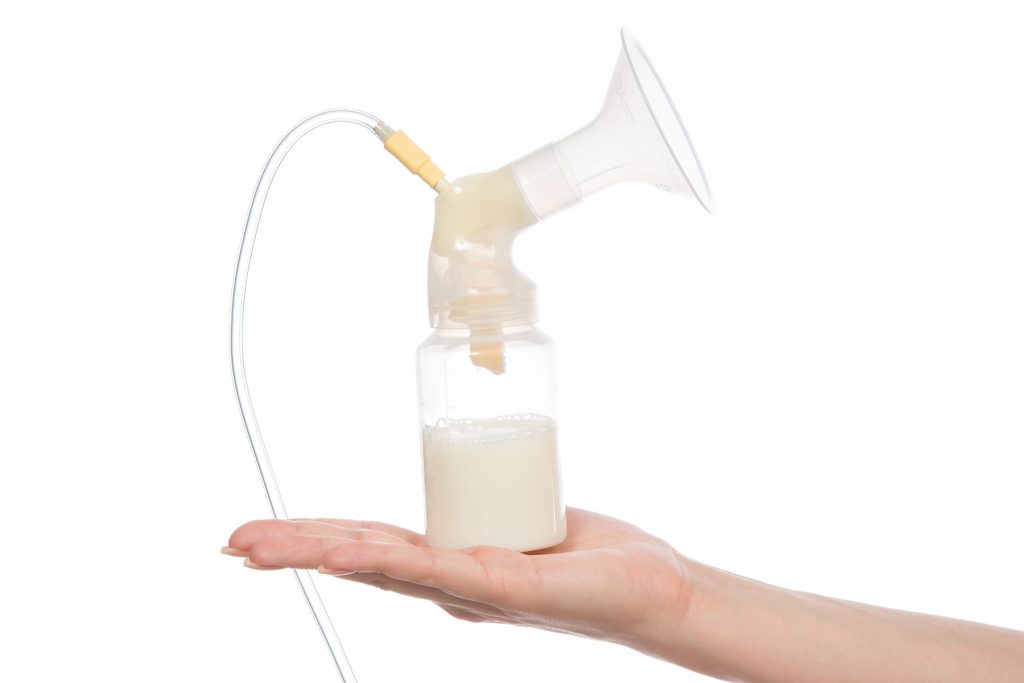
Did you know that a crucial part of breast pumping is getting a breast pump flange that fits correctly? Comfort and fit are important in pumping because they facilitate ease of milk flow. Breast pumping should never be painful, and an ill-fitting flange can lead to loss of milk or skin irritability. At Pumps For Mom, we know how critical it is to find your perfect pump. You’ll likely be using your pump for a while, and you want to get the most breast milk you can to feed your little one. Below, we break down everything you need to know about breast pump flanges and their sizing.
A breast pump flange, also known as a breast shield, sits on the nipple while you use a pump to breastfeed. It’s shaped like a funnel, forming a vacuum seal around the nipple. This helps create the suction necessary to extract milk from the breast during pumping. Flanges typically range from 15 to 36mm, and most generic pump kits will come with a 24mm flange. If you need help measuring, a lactation specialist can assist you in finding your correct flange size.
Breasts are not all the same size, and it’s important to make sure you’re using the flange size that’s best for you. If your flange isn’t the right size, it may rub your skin and make pumping painful. Using the wrong size may also lead to clogged milk ducts that block flow. A loose flange won’t provide enough suction and can lead to lower milk production.
Measure your nipple with a tape measure or ruler to accurately determine your flange size. One of your best options is using the metric side of a fabric measuring tape. Measure the base of your nipple, and do not include the areola. As your body changes after pregnancy, you may find that your flange size changes over time. That’s fine, as most pump kits come with different flange sizes or you can order more.
Flange size depends on your measurement, typically adding on 4mm as follows:
If you have the correct flange size, it should feel comfortable, and only your nipple should enter the pumping tube. Your nipple should not rub against the side of the tube, and you shouldn’t feel any pain when you’re done pumping.
If your flange doesn’t fit correctly, you might notice nipple rubbing, pain, or your areola entering the tube. You may also notice skin irritation, blood circulation issues, or full breasts even after pumping. A too-small flange means your nipple won’t be able to move freely in the tunnel and milk flow may be slow. A too-big flange means you won’t get a good air seal and you’ll feel discomfort.
If your flange is just right, your nipple will be centered and be able to move in the tunnel. You shouldn’t feel any pain, and your breast should be drained to your complete satisfaction after pumping. Many lactation specialists recommend the “COMFY” test to make sure you have the correct sizing.
C – Center Nipples Move Freely
Your nipple shouldn’t touch the sides of the tunnel. If it rubs too much, this may cause redness or pain.
O – Only a Little Areola Tissues Should be Pulled Into the Tunnel
Most of your areola should remain outside of the suctioned area in the tunnel. If too much of your areola is getting inside the tunnel, your flange is likely too big.
M – Motion of Your Breast is Gentle and Rhythmic
Your breast should gently move back and forth with the pump’s movement.
F – Feels Comfortable Breast Pumping
Pumping should not cause pain or tenderness. If you’re feeling discomfort, readjust or try a different flange size.
Y – Yields Well-Drained Breasts
Your breasts should feel lighter and emptied out after you pump. If not, your flange might not be facilitating milk flow as it should.
Many of the breast pump brands at Pumps For Mom offer their own breast pump flanges that feature special qualities such as comfort and flexibility. Below are some of the best flanges from the top breast pump brands.
Ameda’s CustomFit Breast Pump Flanges make breast pumping more comfortable with funnel-shaped pieces. These flanges come with an angled design and various size options for a better pumping experience. Five different flange sizes are available for your specific needs. Try the Ameda Mya Joy to experience CustomFit flanges.
Lansinoh’s ComfortFit® flanges feature a soft, comfortable rim that helps maximize pumping efficiency. ComfortFit® flanges are compatible with Lansinoh® pumps and are BPA- and BPS-free. Customers love their flexible edges and secure seal that allows for better milk flow. Try ComfortFit® flanges with the Lansinoh Smartpump 2.0 Deluxe.
Medela’s PersonalFit Flex™ breast shields offer pumping comfort and efficiency with special technology that allows easy adjustment. New Flex™ Technology shapes specifically for your body with a 105° opening angle that reduces pressure on the breast. Personalized fit and an oval shape offer comfortable, flexible positioning and personalized adaptability. The Medela Freestyle Flex offers PersonalFit Flex™ Breast Shields that adapt to your breast shape and enable 11.8% faster milk flow.
As you’re measuring your flange size, keep in mind that it may change and that it’s ok to try out different pieces until you find your perfect fit. The team at Pumps For Mom is here to help with any questions you have and any of your flange needs. If you want to know more about how to measure or how to get a free breast pump through insurance, reach out today to start the process!